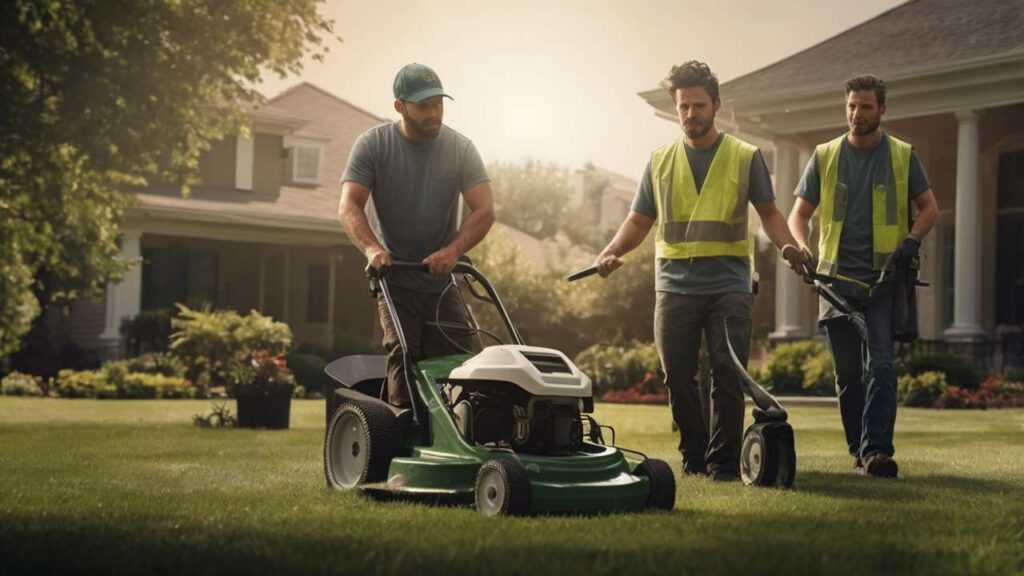A lawn can be the pride of a home—or its biggest stress. Ignoring lawn care has been said to cost homeowners not just money, but their weekends, their energy, and sometimes even their sanity. I learned that the hard way. My first attempt at DIY lawn care was driven by optimism: buy a mower, sprinkle some fertilizer, and hope for a lush, green carpet by summer. But after spending hundreds on equipment and supplies, my lawn still looked patchy and tired. That’s when I started comparing professional lawn care vs. DIY in terms of cost, time, and actual results.
It’s easy to assume DIY is cheaper because you’re not paying a company. But the hidden costs tell another story. Equipment breaks, products don’t always work as advertised, and you may not realize the value of your own time until you’ve lost entire Saturdays pushing a mower under the blazing sun. Meanwhile, professional services offer convenience and expertise, but their pricing models can confuse first-timers. So, what’s the smarter choice? Let’s unpack this with real numbers, expert opinions, and a fair look at the financial benefits of both sides.
The Real Cost of DIY Lawn Care
On paper, DIY lawn care seems straightforward: buy a mower, grab fertilizer, maybe some weed control. But add it up and the costs creep fast. A decent push mower alone can run $350–$600, while riding mowers easily climb past $2,000. Then there are trimmers, blowers, spreaders, and safety gear. Yearly expenses on fertilizer, weed killer, and pest treatments often reach $300–$500, depending on lawn size.
And don’t forget repairs. My mower belt snapped once in the middle of peak season; replacing it cost $90 and a half-day of frustration. A friend of mine burned through two cheap trimmers in two summers. These are the hidden costs of DIY that rarely get mentioned in casual conversations.
Experts emphasize the value of soil knowledge in lawn health. As a turf specialist in Raleigh explained: “Fertilizer applied at the wrong time or on poor soil is like pouring money onto concrete. Without testing and aeration, most of it is wasted.” This connects directly to guides such as Decoding Your Dirt: Why Soil Testing and Aeration Are the Foundation of a Healthy Lawn, which underline the science most homeowners overlook.
So yes, DIY might look cheaper at checkout, but the true annual expense often rivals professional care—and you carry all the responsibility.
Time: The Most Overlooked Cost
Even if you don’t mind the expenses, there’s the matter of time. Mowing, edging, fertilizing, spraying weeds—it all adds up. The average homeowner spends 70 hours per year on lawn maintenance. That’s nearly two full workweeks.
Here’s the kicker: time has value. If your hourly wage is $25, then 70 hours is $1,750 of “lost” value. Compare that to hiring a trusted professional team for $1,200–$1,500 annually, and suddenly outsourcing lawn care looks like a better return on investment.
For me, weekends are scarce. I eventually realized that pushing a mower meant missing family outings or even just downtime to recharge. Outsourcing wasn’t just about cost—it was about lifestyle.
Professional Lawn Care Services: What You Actually Pay For
Hiring a professional isn’t just paying someone to mow. You’re paying for reliable expertise, specialized equipment, and consistent results. Professionals follow structured schedules like those described in Beyond Mowing: A Professional Lawn Care Schedule for Year-Round Turf Success (see the full guide here).
This means aeration in the fall, pre-emergent treatments in early spring, pest control during summer, and even soil balancing throughout the year. Their commercial-grade machines cut cleaner and faster, and they use calibrated spreaders and sprayers for precise application.
As one lawn care manager told me: “Homeowners buy products at the store. We buy results.” That’s the heart of professional service—knowledge applied at the right time, with the right tools.
The financial benefits of professionals extend beyond aesthetics. Healthy lawns improve property value. According to The Curb Appeal Advantage: How a Healthy Lawn Increases Your Home’s Value and Lifestyle, buyers consistently pay more for homes with thriving landscapes. In this sense, professional care is not just an expense but an investment.
Breaking Down the Numbers: DIY vs. Professional
Let’s compare a typical year for a mid-sized lawn:
- DIY Costs:
- Equipment (mower, trimmer, blower): $500–$1,000 initial, plus $100–$200 annual upkeep
- Fertilizers, seed, weed/pest control: $300–$500
- Fuel and miscellaneous: $75–$150
- Total yearly average: $500–$900 (after initial equipment purchase)
- Professional Costs:
- Standard package: $1,200–$1,500 annually (varies by region and services)
- Includes fertilization, weed control, mowing, edging, aeration, and sometimes pest control
While DIY may save a few hundred annually, it costs you 70+ hours of labor and risks inconsistent results. Professional service, though higher in direct dollars, provides reliable outcomes and frees your time.
Hidden Costs and Hidden Benefits
Here’s something that rarely makes it into neat comparisons: stress. DIY lawn care often comes with failed experiments. I once over-fertilized a patch, turning it neon yellow overnight. Another year, I applied weed killer during a heatwave—burned half the lawn. Fixing mistakes cost me more than I’d saved.
Professionals, on the other hand, prevent these mishaps. They also carry insurance, meaning if something does go wrong, you’re not footing the repair bill. That peace of mind is a hidden benefit worth factoring in.
And let’s not forget the broader environmental aspect. Reliable companies often focus on eco-friendly methods: precise chemical use, recycling yard waste, and water-conscious practices.
Beyond the Current Debate
The professional lawn care vs. DIY question opens doors to deeper topics worth exploring. For example, many readers want to understand organic lawn care solutions—can they match chemical treatments for results? Others are curious about climate-adapted turf species, selecting grasses that thrive in changing weather patterns.
Another rising theme is smart lawn technology: robotic mowers, irrigation sensors, and apps that predict fertilization windows. These innovations may soon reshape the cost-benefit analysis itself, blending DIY control with professional precision.
By situating this conversation in the bigger picture, homeowners can make informed decisions not just for this season, but for the next decade of lawn care.
Case Study: The Switch to Professionals
A family in Cary, North Carolina, shared their experience with me. After five years of DIY, their yard remained patchy despite endless weekends of effort. They switched to a professional lawn care company in North Carolina (see recommended providers here) at $1,400 per year. Within one season, the lawn was thicker and greener than ever. The husband admitted: “I regret not outsourcing sooner. I thought I was saving money, but in reality, I was paying in stress.”
That testimony illustrates how financial analysis must consider more than dollar signs—it’s also about quality of life.
Frequently Asked Questions
1. Is professional lawn care really worth the extra cost?
Yes. While it may cost more upfront, the return includes healthier turf, higher curb appeal, saved time, and fewer costly mistakes.
2. Can DIY lawn care match professional results?
In some cases, yes—if you invest heavily in equipment, education, and consistent effort. But most homeowners find professionals deliver more reliable long-term outcomes.
3. What’s the average annual expense difference between DIY and professional lawn care?
DIY averages $500–$900 per year (after equipment purchase). Professional service ranges $1,200–$1,500, but saves 70+ hours of labor annually.
Deciding between professional lawn care vs. DIY is not just a financial choice—it’s about lifestyle, results, and priorities. If you enjoy the labor and learning, DIY can be rewarding. But if your time is better spent elsewhere, trusted professionals offer consistent, expert-level care that protects both your lawn and your peace of mind.
If this analysis helped you see the trade-offs more clearly, please share this article on your social media using the buttons below. And for deeper insights into lawn care strategies, explore these resources:
👉 Professional Lawn Care Companies in North Carolina
👉 Lawn Care Services Category
👉 Pro Service Tips Homepage



